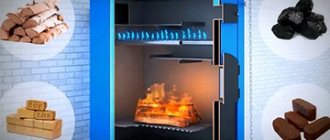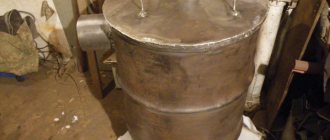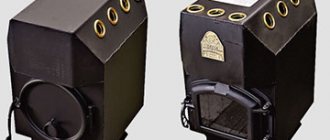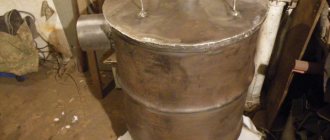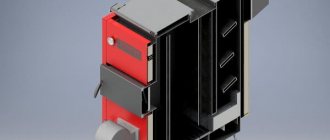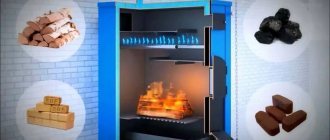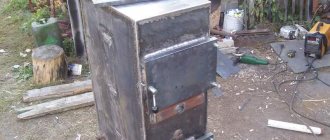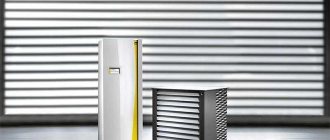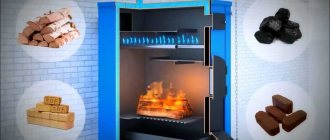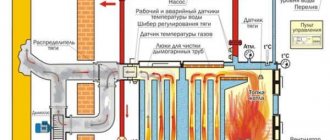Home / Solid fuel boilers
Back
Published: 08/10/2019
Reading time: 6 min
0
5410
Mine boilers (MC) with long-burning pyrolysis type or Kholmov boilers are one of the types of solid fuel heat generators. They belong to the class of energy-independent and efficient units, with forced or natural movement of the gas-air environment.
Typically, mine boilers are manufactured at industrial sites, however, today there are many designs made by hand by craftsmen in compliance with the requirements of regulations and standards in the field of manufacture and safe operation of boiler plants.
Many devices are equipped with energy-efficient features with an additional water heating circuit and storage tank.
- 1 Kholmov's boiler
- 2 The principle of operation of the boiler
- 3 Advantages and disadvantages
- 4 Manufacturing a mine pyrolysis boiler 4.1 Algorithm for creating a boiler with your own hands.
Technical characteristics of top combustion boilers using solid fuel
Top combustion boilers are produced with different powers from 8 to 95 kW.
Some models can reach 1200 kW. The higher the indicator, the more efficient the unit’s operation and the larger the area that can be heated. Boilers with minimum power are designed for installation in small houses. Ukrainian "Burans" with 40 kW are intended for heating large houses or warehouses. Solid fuel boiler BURAN-EXTRA 1200
Boiler manufacturing materials are cast iron or steel. A cast iron heat exchanger is more durable, but due to its heavy weight it can cause installation difficulties. Steel heat exchangers are made from steel of various qualities, from low-grade to high-quality, resistant to high temperatures. In addition, steel boilers are often protected by fireclay bricks.
Most often, top-burning boilers operate on wood, but there are models in which coal, peat briquettes, shavings and other fuel can be placed.
The boiler efficiency is 85-93%. According to the manufacturers, the operating time of the device after one load of firewood ranges from 8 to 31 hours, and on coals up to 5 days. The average inexpensive boiler produces heat within 5-8 hours.
Water heating temperature is 70 C for wood and 85 C for coal. The recommended inlet temperature is from 60 C. The heating system can be either natural or forced circulation.
Long-burning solid fuel boiler - varieties.
The honorary title of a long-burning solid fuel boiler is given to any device that maintains combustion throughout the day. If a boiler burns out for a day, it gets the long-burning status, if two boilers burn out, the status doesn’t change, if it burns out for a week, they all get the same name.
Thus, we can find a device with a different period of fuel smoldering support, while the very phrase “long-burning solid fuel boiler” is unlikely to reveal to us all the technical characteristics of the device.
Only two main types of equipment are distinguished in this segment - a long-burning wood boiler and a long-burning coal boiler. Both devices are capable of servicing both a water circuit system and a glycol-based coolant system. In addition, a long-burning solid fuel boiler has a number of distinctive features, which we will focus on.
Manufacturing of a mine pyrolysis boiler
Today, modified PCs are in great demand, with high efficiency, allowing to save a significant amount of fuel and functioning from one filling for more than a day. The simplicity of the design allows the boiler to be manufactured with even little experience in welding.
Drawing of an ordinary pyrolysis boiler
The basis for creating an effective Kholmov boiler with your own hands will be reliable design documentation: drawings, specifications and calculations, which today can be found on the Internet.
Algorithm for creating a boiler with your own hands.
- They make the main part of the device and divide it into two chambers, installing partitions and valves for air supply.
- The diagram of the parts is transferred to a metal sheet and cut out autogenously.
- The side elements are welded using a reinforced seam.
- Between the boiler and the firebox, 2 holes are cut in the partition - at the top and bottom near the grate.
- Install the furnace parts and scald them.
- Place the valve at the top hole and secure it.
- Grate bars are made with narrow longitudinal slits cut.
- The grate bars are placed on metal corners (cast iron) or welded (steel).
- The doors of the firebox and ash pan are made.
- A boiler made of 25 mm pipes with a water jacket is installed and scalded.
- They set up an afterburning chamber for the smoke-gas mixture by welding a partition next to the grate.
- A hole is made at the bottom to install a 50 mm air pipe with a blind damper at the outlet end and many holes to create a uniform air flow.
- The combustion chamber is insulated with chamotte, and then it is additionally insulated with basalt wool, which increases the thermal efficiency of the boiler unit.
- Next, they install the manufactured equipment, connect the water and smoke gas ducts, install the heating, and then pressurize the system.
How to fire a mine boiler with wood
To achieve maximum thermal efficiency, you will need to learn how to properly heat a long-burning wood-burning mine boiler. Only in this case will it be possible to achieve the parameters specified in the technical documentation:
- Autonomous operation for 6-8 hours.
No smoke in the room.
Sufficient heat dissipation.
As practice shows, most consumers find it difficult to switch the usual combustion of wood in a mine boiler to gas generation mode. To do this, perform the following steps:
- Fire wood as usual.
Wait for 15-20 minutes until the boiler reaches operating capacity.
Switch the device to gas generation mode.
If the firewood is selected and stacked correctly, firing the boiler will not cause any inconvenience.
What kind of firewood is best for a shaft-type boiler?
Despite the “omnivorous” nature of the equipment, the efficiency of a mine boiler directly depends on the degree of moisture content of the wood. The operating instructions indicate that the following raw materials, in addition to firewood, can be used for the firebox:
- Briquettes.
Wood waste.
Pellets.
Sawdust and wood chips.
But the main type of fuel for a wood-burning boiler with a shaft firebox remains wood. Even if you plan to use alternative types of fuel, care must be taken to ensure that at least about 40% of the load is well-dried logs. This way, you can ensure maximum heat transfer from the equipment.
Manufacturers recommend heating boilers with any hard wood. It is not recommended to use resinous rocks, as this leads to a reduction in the service life of the boiler.
How to properly stack firewood in a mine boiler
One of the main problems indicating improper stacking is wood hanging in the shaft. The fact is that combustion occurs only at the bottom of the combustion chamber. The firewood falls naturally under its own weight.
Any non-compliance with the recommendations leads to logs getting stuck and, as a result, stopping the combustion process. To prevent this from happening, follow these recommendations:
- The filling is carried out with logs several centimeters smaller than the size of the combustion chamber.
Firewood is stacked across the firebox, not along it.
Dry logs are placed on the bottom; wetter logs can be placed on top.
Detailed instructions regarding fueling and ignition are found in the operating instructions supplied by the manufacturer.
Advantages and disadvantages of shaft-type wood-burning boilers
Hot water boilers with a shaft bunker for firewood have several positive aspects:
- Versatility - boilers can operate on almost any type of solid fuel. It is allowed to use firewood with a relative humidity of 45%.
Performance - models offered by various manufacturers are designed for heating private houses, cottages, industrial and warehouse premises.
Autonomy - non-volatile mine TT boilers with long bottom burning on wood, do not depend on the availability of electricity. In economy mode, one stack of firewood will last from 12 to 24 hours. At maximum load, you will have to add fuel after 6-8 hours.
Simple maintenance - loading fuel and cleaning the chamber, is carried out through different hatches. There is no need to stop the boiler to clean the shaft. The ash is poured into a special box and then removed.
Safety - operation of the boiler does not require the use of complex automation; it occurs in a simple but effective way. The danger of smoke entering the room and carbon monoxide poisoning is almost completely eliminated.
The good technical characteristics of the mine boiler and at the same time the simplicity of the design and internal structure have led to the appearance of many diagrams and drawings indicating how to make a heat generator of this type with your own hands.
It is impossible to completely replicate the quality of factory assembly at home. The result of independent production was an increase in accidents. Safety can only be ensured by heating units manufactured at the factory and having the appropriate certification.
Long-burning solid fuel boiler - pros and cons
In the absence of a gas main, there are not many alternatives to build a heating system. You can install a gas tank, provided that gas supplies are established in the region. You can use environmentally friendly, but expensive electricity by connecting an electric boiler. But what to do if such options are not affordable? Or are gas and electricity resources limited or non-existent?
A long-burning solid fuel boiler will not require significant installation costs from the owner and will provide a reasonable replacement for the listed heating methods.
Advantages:
- Easy to use. Traditional work with wood, pellets or coal does not require special skills. Cleaning up ash takes no more than an hour a week.
- Durability. Service life exceeds 10 years. A long-burning boiler is an unpretentious technique. A simple design, with careful operation, can serve for several decades.
- Ecologically pure . The afterburner ensures almost complete combustion of the fuel. Emissions of harmful substances are a natural product of combustion - processed as a result of photosynthesis.
- High efficiency . There are models on the market with a value of up to 90 – 95%. Minimum heat losses are ensured. Engineering solutions optimize the process of afterburning pyrolysis gases. The heat exchanger design is designed with maximum heat transfer to the coolant.
- Efficiency and economy . Modern equipment is not much inferior to gas analogues. The effectiveness of long-term burning reaches seven or more days.
- Reasonable fuel cost. Sometimes it’s the only possible one. Frees you from dependence on expensive gas equipment.
- There is no permitting documentation for installing the boiler. There is no requirement to conclude service agreements with gas services.
- A long-burning solid fuel boiler allows you to provide home ownership with hot water, if there is a second circuit. In addition, an indirect heating boiler will help expand functionality.
Flaws:
- Constant involvement of the owner . Despite the long combustion process from one load, sooner or later you have to return to replenishing the loading compartment with fuel.
- Regular cleaning . Probably the least popular maintenance process, it requires constant cleaning of ash. All that remains is to envy the clean gas equipment or electrical appliances.
- Separate room . You will have to allocate a separate room with good ventilation and a chimney. A long-burning solid fuel boiler for a private home usually has significant dimensions; it may be necessary to prepare a special installation site with a reinforced foundation.
- Maintenance of fuel stocks . Replenishment and preservation of fuel residues will require additional financial investments. Compliance with safety measures and maintaining a certain moisture content of the product also adds problems in resolving storage issues.
How to use the device
Optimal performance of any equipment depends on operating conditions and fuel characteristics. To prevent soot and condensation from forming in the air ducts, the furnace must operate in optimal mode. “Stifled” operation with a lack of air leads to a sharp decrease in efficiency: the boiler consumes a lot of firewood. It burns for a long time, but heats weakly.
Boiler room
The boiler room has the following important parameters:
- Isolation. Smoke from kindling should not enter living spaces. It is optimal if the boiler room is located outside the residential premises, in a separate building or room with access from the street.
- Volume and ease of maintenance. The equipment is installed on the foundation, and there is free space around it for easy access to the piping units, valves, and cleanings.
- Availability of chimney and ventilation. Long-burning solid fuel boilers are prone to increased condensation formation. A brick chimney is not suitable - condensation will penetrate through the masonry. It is worth using stainless steel sleeves and ceramics.
Fuel
Solid fuel boilers will operate in long-burning mode only if appropriate fuel is available. There are no miracles - to obtain a kilowatt of energy you need to burn a certain amount of energy. The amount of fuel is calculated simply: you need to know the calorific value and multiply it by the efficiency of the boiler.
Firewood. Only dry wood should be used, preferably hardwood. The preparation costs will be repaid by trouble-free heating operation.
Pellets. The manufacturer supplies ready-made high-calorie and technologically advanced fuel. Pellets are free-flowing, but do not leave debris. They were invented to facilitate the transportation of industrial waste. Pellet fireboxes are easy to automate; with large bunkers, the boiler can burn for months without human intervention!
Sawdust, wood chips. The use of wood waste has 2 problems: moisture and debris. Sawdust has a fairly low density, therefore, low calorific value.
This pays off with the low cost of fuel; many enterprises give it away for free or for next to nothing.
Loose plant residues: straw, cake, husks. A new word in alternative energy is the use of renewable fuel. Residues from production, straw, sunflower stalks and other local fuels were previously disposed of as garbage. The use of such fuel pays off due to its low cost, but it is worth using if there is a constant opportunity to purchase a new batch.
Difficulties in storing and transporting bulk fuel are solved using containers, big bags, and packaging in paper bags.
Attention! You cannot store such fuel in a large pile! Moisture condenses, the fuel begins to rot, overheats, and there is a risk of spontaneous combustion. It is more convenient to store in bags placed on shelves for air access
It is more convenient to store in bags placed on shelves for air access.
Rules for safe use
- Chimney installation. It is where the chimney passes through the ceilings that fires begin. Good thermal insulation of the chimney and compliance with operating rules will protect against fire.
- Periodic cleaning of soot from the heat exchanger and chimney. Uncleaned chimneys can cause soot to catch fire. The combustion temperature of soot is above 1000 °C, and a huge number of sparks fly from the chimney. Dangerous! There is a huge risk of fire!
- Do not leave open flames unattended. Do not entrust heating to children or people with mental disabilities.
- Long-burning boilers are technological devices. Read the instructions carefully and follow the manufacturer's recommendations.
Advantages and disadvantages of homemade boilers
Do-it-yourself, long-burning wood-burning boilers are becoming increasingly popular, the reason for this being the obvious advantages of such units:
- The duration of operation from one filling of the firebox with wood is 2 times longer than that of traditional boilers, and from 1 loading of coal – 3 times.
- The simplicity of the design allows you to make a boiler installation yourself, which will be much cheaper than a factory-made analogue.
- Possibility of design improvement. For example, the “trendsetter” in this direction, the STROPUVA brand, indicates in its technical specifications an operating pressure of 1.6 Bar. This is a low indicator; by strengthening the design, you can make your own solid fuel boiler with a working pressure of up to 3 Bar.
- Undemanding to the type of fuel. You can put firewood, coal, sawdust and other combustible waste into the combustion chamber. The main thing is to provide air access to it. There are also no special requirements for wood moisture content.
Craftsmen have somewhat simplified the design so that homemade long-burning boilers using coal or wood can be made at home. The change concerns the way air is supplied to the firebox. The folding telescopic structure is quite difficult to manufacture and requires additional costs.
Instead, they install a steel pipe, the length of which is 300-500 mm greater than the height of the firebox, welding a “pancake” and air diffusers at the end. The other end simply sticks out of the boiler lid; an air damper is made on it to regulate the air supply, which is turned manually. A fan is not used for injection; combustion occurs due to natural draft. Changes in the design can be traced by studying the drawings of solid fuel boilers made by yourself.
The disadvantages of homemade long-burning boilers largely replicate the shortcomings in the design of factory units. But there are ways to fix them:
Difficulties in manufacturing a cylindrical body. Without a rolling machine or at least a pipe bender, it is very difficult to make a round body from sheet metal. As an option, craftsmen use propane cylinders or pipes of the appropriate diameter for heating. This will add weight to the structure, since standard large-diameter pipes have a wall thickness of 5 mm or more. To make a water jacket, it is better to use thin-walled pipes.
Factory long-burning boilers are difficult to ignite when the combustion chamber is loaded to a quarter. Long-term operation of the unit is not always required; sometimes you need to heat the house a little. The boiler body is round and high; it is very difficult to fill the firebox a quarter of the way through the loading door and light it up. In homemade units, you can provide an additional door in the middle, not forgetting about its high-quality sealing.
Due to the design features, it is not recommended to load long-burning wood or coal boilers with fuel “on the go”; you must wait until the previous portion is completely burned. If you lift a load during operation and open the door to load firewood, smoke will pour out of it directly into the room. You will have to throw wood quickly and somehow, this is unacceptable. The deficiency can be treated by installing a heat accumulator, which experts recommend including in the piping of any solid fuel boiler.
In the upper position, the air supply pipe of a homemade boiler will stick out to a height equal to the height of the firebox. This should be taken into account when choosing a location for the water heating installation.
Controlled combustion
An important condition for organizing the combustion process and heat extraction is the arrangement of air supply. This is possible in three ways:
- by adjusting the angle of the flap on the blower door
- forced supercharging;
- by installing a smoke exhauster on the boiler smoke pipe.
Mechanical traction control
In the first case, the damper is opened slightly either manually or mechanically. The principle of operation is such that, depending on the temperature of the coolant, the air supply damper opens or closes. The regulator, located in a special immersion sleeve, is attached to a certain place in the housing so that it is in contact with the coolant. The temperature-sensitive element reacts to the temperature of the water and, changing in volume, affects the rod. A chain is attached to the damper rod and lever. By loosening and tightening the chain, the lever changes the angle of the damper and, accordingly, the amount of incoming air.
Forced boost
Forced air supply is needed:
- during the ignition period;
- in case of poor quality fuel;
- when using raw materials with a low content of volatile substances (coals, coke);
- in case of accelerated startup of the boiler for quick heating of the premises.
The fan eliminates the influence of poor draft and weather fluctuations. The adjustment is carried out by special automation. Controlled combustion of fuel makes it possible to save its quantity while obtaining higher heat transfer.
Using a smoke exhauster
The smoke exhauster is also a fan, but it is protected from high temperatures and volatile inclusions. A smoke exhauster, unlike a fan, does not create increased pressure, but a vacuum in the firebox of 20–25 Pa.
Just like a boost fan, a smoke exhauster allows you to control the combustion process. In addition, it eliminates the possibility of smoke in the room when additional fuel is added while the boiler is operating. Using a smoke exhauster eliminates combustion problems associated with chimneys. Since a vacuum is created throughout the entire gas-air path, it is the smoke exhauster that protects from excess smoke when the combustion chamber door is open. And also from leaks of toxic carbon monoxide, which, as you know, has neither color nor odor.
How to heat so that coal burns as long as possible
The correct firing of a long-lasting coal boiler largely depends on the presence of control automation and, of course, the quality of the coal itself.
What coal is better to use
Manually operated boilers can operate on coal of any fraction. But it must be taken into account that the temperature of the gases in the chimney during long-term combustion is much lower than during direct combustion: the use of raw fuel can lead to the accumulation of excess moisture in the pipe and the formation of condensation - a black viscous liquid with a tar smell. Therefore, the relative humidity of coal (like any other solid fuel) should be no more than 15–20%.
Correct firebox
The combustion of a long-burning boiler is carried out according to the following scheme:
- Fuel loading - the distributor is raised to its original position so that it is just above the loading door, and all the coal is immediately poured.
- Kindling - dry wood chips and paper are placed on top of the coal, after which they are ignited and burn with the top door open and the air duct closed.
- Combustion - when the temperature in the heat exchanger reaches 50-60 °C, the door closes tightly, then the telescopic air duct regulator opens.
- Temperature adjustment - the boiler automatically enters the optimal mode, but if necessary, the temperature is adjusted by the air duct damper.
Upon completion of the full combustion cycle, it is necessary to remove sintered pieces of coal from the loading chamber, clean the ash pan and fill in a new batch of fuel.
Features of the combustion process in the afterburner
The initial combustion conditions are such that the boiler operates with some underburning, and full oxidation does not occur, but a lot of carbon monoxide (CO) is formed instead of carbon dioxide (CO2). Secondary air, having heated up under the cast-iron grates on which the fuel smolders, enters under the welded part of the grate in the second chamber (hump). When passing through the numerous holes of the catalyst, an excess of incoming air is created, which raises the combustion temperature of the flue gases flowing through the gas gap to a thousand degrees. The reaction of converting CO into CO2 occurs. Next, the combustion products rise up and flow around the heat exchanger, giving off heat. Afterwards they head into the chimney.
Manufacturing instructions
When starting the production process, you need to start by preparing all the essentials:
- Pipes with the following diameters - 30 cm, 5-6 cm, 10 cm (the wall thickness of each is at least 3 mm)
- Steel sheet with a thickness of more than 4 mm
- Bulgarian
- Welding machine
- Hand tools
It is recommended to place the boiler on a level, hard surface. If such an installation will be installed at home in a boiler room, you should think about arranging the foundation, a few words about which will be said later.
Let's start making the boiler:
- Take a pipe suitable for its characteristics and cut off a piece from 70 to 100 cm. A short length will not allow you to load a sufficient amount of firewood, a large length will make loading extremely inconvenient
- Now you need to build a distributor. In order for it to move freely, its diameter is made 15-25 mm smaller than the main pipe
In the center of the circle you need to drill a hole with a diameter of 15 mm - air will flow through it into the combustion chamber. To ensure that the disk does not fit tightly to the panels and there is space for air circulation, it is necessary to weld an impeller to its inner side - several plates up to 5 cm high
A pipe with a diameter of 5-6 cm is welded in the center of the regulator, while its height is made 10-15 cm larger than the boiler. As mentioned earlier, it is recommended to make a damper at the top, which will allow you to adjust the draft at any time, thereby controlling the smoldering process. A door is cut out at the bottom with a grinder, through which ash will be removed
Also, the bottom is securely welded at the bottom of the boiler. At the top it is necessary to run a horizontal chimney pipe with a diameter of 8-10 cm and a length of no more than 40 cm (this is what is passed inside the heat exchanger)
The finishing touch of the design is the boiler lid, in which a hole is cut for the air intake pipe. It should lock the camera as tightly as possible
A good alternative to firewood is heating briquettes - see our review
Chimney and reflector
The walls of the boiler will constantly heat up and radiate thermal energy. If the installation is installed to heat a small room, reflectors should be placed around it - they will distribute the flow, increasing the heat flow inside.
If the oven will be located in a room where people are constantly present, you should think about their safety. One solution to the problem is to cover the structure with brickwork.
The chimney can be made from a 20 mm pipe. The horizontal straight section should be 5-10 cm larger than the diameter of the combustion chamber. It is necessary to take it outside with a minimum number of bends - 2 x 45 degrees.
A few other features:
- It is recommended to make the chimney collapsible so that it can be easily cleaned of soot 2-3 times a season
- The chimney sections must be connected in the direction opposite to the gas movement
- All structures and objects that are easily flammable must be kept at a safe distance
We are building the foundation
It can be assumed that a long-burning wood-burning stove will constantly heat up to high temperatures. A simple leveled floor is not the best solution for it - a foundation should be built.
The base can be made of burnt brick or rubble. They do not heat up when exposed to elevated temperatures. All those who want to make a more solid foundation can pour a solid monolithic slab.
The boiler can also be installed on legs, which can be easily welded from channel wood. They hide from view behind brickwork.
Using the boiler
Unlike a classic stove, air must enter a long-burning wood-burning boiler in a certain quantity. To achieve this, the filling must be done in full, trying not to leave any free cavities. It is recommended to add sawdust, pellets, peat or combustible waste to the logs.
Fuel must be added according to the following instructions:
- Remove the cap and remove the regulator from the tank
- Pack the fuel tightly
- Spray flammable liquid on top
- Install the regulator, cover with the lid and open the damper
- Throw a splinter into the air pipe and when it starts to smolder, close the damper
Let's sum it up
A simple long-burning wood-burning boiler is ready. You can install such a structure in any unheated room: from a small garage to a workshop. If everything was done correctly, there will be no doubt about the efficiency and high efficiency.
Self-installation of the device
A self-made, long-burning wood-burning water stove must be installed correctly. In order to carry out all the manipulations correctly, you need to adhere to certain installation rules:
1. First of all, you need to make a base for the product. Naturally, the installation location must be suitable. Try to install the boiler in a room where flammable materials are not stored. It should be well ventilated. It is advisable that this room should not be accessible to small children.
2. Bricks and high-quality concrete can be used to make the foundation. The base is necessary for the structure to be installed level. Moreover, the presented boiler is quite heavy.
3. All connecting seams must be pre-checked.
4. After connecting the heating system, the boiler can be checked. If everything is in order, then the installation was completed correctly.
If you are not confident in your abilities, it is better to entrust this work to specialists.
Features of installing roller blinds
When installing roller blinds, there is no need to drill mounting holes, which undoubtedly simplifies the entire process of hanging the equipment. There are two types of fastenings for roller window systems:
- Fastening with hooks that simply cling to the top of the sash.
- Fastening equipment with double-sided construction tape.
Detailed recommendations for installing curtains with step-by-step instructions are included with each purchased product. By following the instructions for assembling curtains offered by the manufacturer, you can easily and quickly complete the work yourself.
When installing roller blinds, be sure to use a building level; this will protect against distortions and help secure the curtains as accurately as possible.
Principle of operation
Increasing the duration of the combustion process is achieved not only by a large firebox. The organization of furnace combustion in the form of layered combustion with upper combustion and upper supply of blast air has a significant impact on efficiency and heat transfer, so gas-air flows do not circulate at all in the lower fuel layers.
Operating principle of a boiler unit with long-term combustion of solid fuel: The air required for fuel combustion is taken directly from the combustion chamber and passes through a preheating stage in the upper heating chamber of top-combustion boilers.
A pipe air distributor is built into the heating chamber to supply hot air to the combustion device. The feeding system can be gravitational or forced.
The air distributor is equipped with channels directed vertically. Before loading fuel, it is raised using a built-in mechanism, then fuel is poured in and the distributor, which rests on the upper fuel level, is lowered. As it burns out, it falls down the combustion space. This movement of the distributor provides air supply to the top layer of hot fuel.
Here, flammable substances burn out completely, transferring heat through the walls of the firebox to the heating fluid circulating in the built-in heat exchanger. Flue gases are discharged through the gas outlet pipe into the chimney. The ash is collected in the ash box located at the bottom of the boiler unit, under the firebox. The volume of the box allows it to be cleaned at intervals of 2 to 5 loads.
Kholmov's boiler
This modification of the stove is distinguished by the fact that it is equipped with two chambers - for installing a heat exchanger and separately for burning fuel. These devices feature bottom combustion and a full-height firebox, which became the name for them. The principle of operation depends on the design.
The most popular today are two designs:
- Kholmov pyrolysis boilers (PK);
- normal combustion.
The fuel burns at the bottom of the closed combustion space. The second shaft is smaller in size and is used to burn exhaust gases and cool them in the boiler for heating water.
Non-volatile devices control the temperature with an RT3 thermostat installed at the front of the structure. To ensure complete combustion of the fuel, the air supply to it is regulated by the blower door located on the main door of the ash pit.
Kholmov's boiler. Top and side view
A special restriction valve is installed to ensure minimal air passage. In the upper rear part of the unit there is a pipe for connecting a chimney that provides natural draft.
The boiler is equipped with a shut-off valve and compensators on the outside and inside the body, designed to prevent welds from breaking during emergency overheating.
Top 5 best models
In the trading network today you can find both relatively inexpensive and simple domestic boiler units, as well as fully functional automatic boilers from Western manufacturers of popular companies: Stropuva - a Lithuanian manufacturer, Buderus - a German boiler brand, WATTEK - a Czech boiler ACV - a Belgian manufacturer of boiler equipment and the Austrian brand Wirbel.
The most popular manufacturers of Russian companies producing long-burning boiler units are Magnum, Novosibirsk Metalworking Company, ZOTA, produced by the Krasnoyarskenergokomplekt company and Teplov Universal of the Kostroma plant.
Stropuva S 15 U
A small Lithuanian boiler with a thermal power of 15.0 kW, capable of heating a house up to 150 m2, is the best unit for heating small private houses. The S 15 U brand is versatile and can operate on any solid fuel.
The best characteristics of the boiler are ensured when using coal; when it is loaded into the combustion chamber of 217 liters, the boiler is capable of operating for 7 days with an efficiency of 86 to 90%, producing a coolant with a temperature of 75 C.
When working with firewood, you should use only dry wood to prevent the formation of tar on the walls of the firebox. The boiler has a mass of 205 kg and a service life of more than 10 years.
Price: 91,500 rub.
Liepsnele L20-U
Lithuanian boiler unit, with a more powerful unit of 20.0 kW, an analogue of Stropuva, with more advanced characteristics and therefore expensive equipment for the unit. It has the most voluminous firebox - 320 liters, and an efficiency almost equal to a gas boiler - up to 91%. The cast iron heat exchanger ensures a service life of up to 25 years.
Fuel versatility allows the use of any solid fuel, but the longest period of operation at 1 filling station, up to 7 days, is provided by coal. The maximum temperature of water leaving the boiler is 80 C.
The low working pressure of the hot medium, 1.5 atm, allows its use only in heating systems with natural coolant movement.
Price: 110,000 rub.
Galmet Top
Polish top combustion pyrolysis boiler with a thermal power of 20 kW, for heating a house with an area of 160-200 m2. This is a very modern universal modification with a 100% level of automation, a smart PID controller, an electric blower fan and weather-dependent automation.
The outlet temperature of the coolant is 55-80 C. The distinctive ability to control two heating circuits: warm floor + hot water, and also has a built-in recirculation pump.
Despite very high-quality thermal insulation, the manufacturer was unable to achieve high efficiency of the boiler; it does not exceed 87% for coal fuel. The heat exchanger is made of steel, so the service life is also not long - 15 years.
Price: 89,000 rub.
Week KO-60
A very popular model in Russia and the CIS countries with a name that is responsible for a week’s work from one load, while the chamber volume does not exceed 160 liters. The power is very high for such dimensions: peak 60 kW, and in long-burning mode 25 kW, controlled automatically and can heat an area of up to 350 m2.
The highest efficiency - 92% is achieved when using high-quality coal. This is also facilitated by the working control panel for the thermal processes of the Prond Proton 405.01 boiler and the WPA X2 blower fan to create pressurization of the boiler.
The heat exchanger and body of the unit are made of very thick combustion steel, which increases service life, although it leads to an increased weight of 420 kg.
Price: 130,000 rub.
Station wagon TA-40
Bottom combustion water heating boiler with top loading Teplov Universal 40 kW from the Kostroma plant has the ability to heat any residential and industrial premises up to 400 m2 with simultaneous preparation of hot water supply. The fuel boiler is universal, capable of operating on any solid fuel.
Automated or non-volatile unit layouts are available for sale. The efficiency of the boiler is not higher than 82% in manual mode; when using automation it exceeds 85%.
The boiler software is capable of maintaining the temperature in the house throughout the day, as well as distributing power according to the “heating - hot water” priorities in 4 modes. Price: 103,500 rub.
A number of useful tips for choosing
Many homeowners are interested in the question of how to choose a double-circuit solid fuel boiler that can operate without recharging for 8 hours or more. The task is not easy, since the best representatives of the tribe of long-burning TT boilers are rarely equipped with a second circuit for DHW. So finding a suitable model on the market will not be easy. Hence the advice: it is better to use an indirect heating boiler together with wood-burning heat generators, allowing for one and a half power reserves.
For reference. In the technical data sheet for a conventional solid fuel unit equipped with a second circuit, hot water consumption is indicated in liters per hour, and not per minute, as with double-circuit gas boilers. The reason is that in the operating mode of the heater, it will provide the specified flow rate only when the water temperature in the boiler jacket is 90 °C.
Now a number of tips on how to choose a suitable solid fuel heat source:
- When you have a choice between a long-running direct- and top-burning boiler, take option one. A conventional unit with a larger firebox will create much less hassle for you.
- If you need to choose between a cast iron and steel heat exchanger, then the first option is preferable. Cast iron boiler elements last much longer than steel ones, but also cost 15-20% more.
- If there is a reliable power supply to your home, it is better to purchase a boiler model with forced air supply by a fan and automation. In standby mode, when the coolant is heated to the desired temperature and the fan is turned off, air access to the firebox is completely blocked and the wood smolders very slowly.
- Choose a heat generator model where the fan is installed on top of the housing. In products with a fan built into the door or side wall, this unit fails faster. The reason is dust and debris that the fan picks up from the lower zone of the room.
- Avoid buying a boiler with water-tube grates (instead of the usual grate there are pipes filled with coolant). Firstly, the fine fraction of coal sticks tightly to them. Secondly, the water-tube grate quickly cools the heat in the furnace, causing the automatic system to operate more often, starting the full combustion mode.
This is what a grate looks like, made of pipes filled with coolant
When choosing a long-burning wood-burning boiler for heating your home, keep in mind that the price of these units is significantly higher. Be careful when communicating with sales representatives of different manufacturers, study the operating instructions for the product. If it says that the firebox volume is 45 liters and the burning duration is 8 hours or more, feel free to refuse the offer, no matter how attractive the price. In reality, you will have to reload such a heater every 4 hours.
